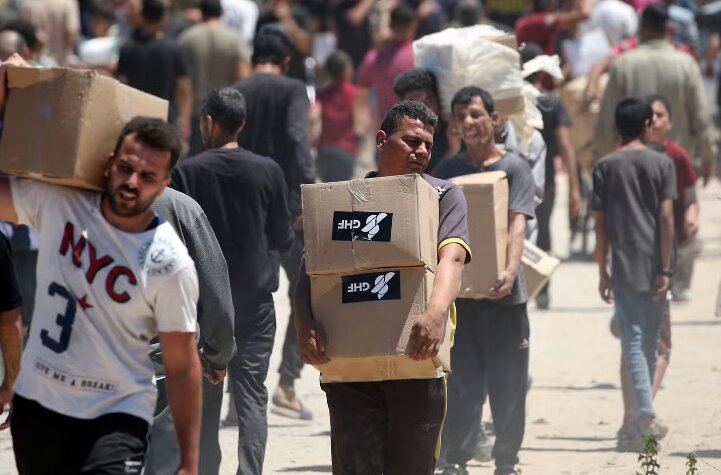Secrecy behind GHF: Ethnic cleansing

TEHRAN - Since March 2, 2025, Gaza has been under a stringent Israeli siege, halting crucial humanitarian items like food, water, and medical supplies. This blockade has triggered a severe crisis for Gaza's 2.3 million residents, with nearly half a million facing acute malnutrition and potential death.
The WHO highlights the dire situation, noting that people are starving while aid is blocked nearby, emphasizing the blockade's deliberate nature.
The IPC reports that 75% of Gaza's population faces "emergency" or "catastrophic" food insecurity, indicating an escalating hunger crisis. UNRWA has denounced the use of aid as a weapon, with Commissioner-General Philippe Lazzarini suggesting these actions could be war crimes or genocide. The destruction of civilian infrastructure further worsens the crisis, increasing the population's vulnerability and undermining resilience.
The Gaza Humanitarian Foundation
Amid this dire context, a controversial new actor has emerged: the Gaza Humanitarian Foundation (GHF). Established in February 2025 in Switzerland, GHF claims to be a humanitarian aid distributor but operates under a veil of secrecy and military backing.
Investigations reveal that GHF functions as a front for a network of private mercenary firms and receives heavy funding from Israeli military-intelligence agencies, including Mossad and the Ministry of War. This funding is reportedly funneled through opaque shell companies, with millions of dollars flowing from undisclosed sources.
Israeli opposition figures have openly accused the Netanyahu government of using GHF to replace UNRWA, which Israel has designated a terrorist organization since 2024. The GHF model is integral to Israel’s broader strategy of ethnic cleansing in northern Gaza, forcibly relocating Palestinians into tightly controlled “humanitarian islands” or concentration camp–like compounds monitored by biometric systems.
Internal GHF documents acknowledge that their aid distribution centers could be perceived as “concentration camps with biometrics,” revealing the dystopian and coercive nature of the operation.
Militarization and mercenary involvement
The GHF’s operations are heavily militarized and guarded by private mercenary firms such as Safe Reach Solutions and UG Solutions, staffed by former CIA operatives and special forces veterans. These mercenaries manage checkpoints and distribution centers, often resorting to violence against desperate Palestinians queuing for aid. On May 27, Israeli soldiers and American security contractors opened fire on crowds near GHF distribution points, killing over 130 Palestinians and wounding more than 150—a brutal repression that starkly contradicts humanitarian principles and exemplifies the weaponization of aid as a tool of control and terror.
Collapse of humanitarian principles and internal dissent
An internal crisis in GHF precipitated the departure of its leadership; even its CEO and COO resigned in protest against the organization's failure to respect neutrality, impartiality, and humanity. These resignations notwithstanding, GHF continues to function under Israeli military protection and with the tacit backing of the U.S. government, which has since endorsed the scheme, providing it with a semblance of legality. This militarized and opaque aid delivery apparatus substitutes for the UN, undermining decades of humanitarian work by UNRWA and other agencies.
UN and WHO statements exhorting the lifting of the blockade and the stopping of any humanitarian access obstruction have been dismissed or actively impeded by the Israeli authorities, hence spurring the crisis deeper.
Broader humanitarian impact
The intentional starvation and siege have precipitated the collapse of Gaza’s health system. Over one-third of essential medical supplies are out of stock, whereas many health facilities have been damaged or destroyed due to the ongoing Israeli raids.
Deaths related to malnutrition, especially of children, are sharply rising; from the beginning of the siege, 57 children are reported to have died of malnutrition, with projections estimating that if the blockade continues, approximately 71,000 children under five will suffer from acute malnutrition within the next few months.
The psychological and social fabric of Gaza is in the process of unraveling, with families facing starvation, displacement, and the constant threat of violence. To use food as a weapon is not only a humanitarian catastrophe but also an outright breach of international law and human rights.
The 2025 Gaza situation takes center stage in demonstrating starvation and manipulated aid as war and tools of ethnic cleansing. Covert control of the Gaza Humanitarian Foundation by the Israeli side and militarized aid distribution violate humanitarian principles, whereas the replacement of UNRWA with a paid operatives' organization erodes international accountability.
The international community's failure to confront the siege and weaponized aid speaks to an acceptance of policies of collective punishment.
The endorsement of the GHF by the U.S., alongside its silence on the human toll, asks for a reflection on the ethics surrounding these acts. Starving the people of Gaza through such methods is an inhumane strategy with terrible consequences. The lifting of the blockade needs immediate attention, along with the restoration of legitimate aid routes and enforcement of accounts, for starvation is a proven policy bearing upon justice, human rights, and the very notion of peace.
Leave a Comment